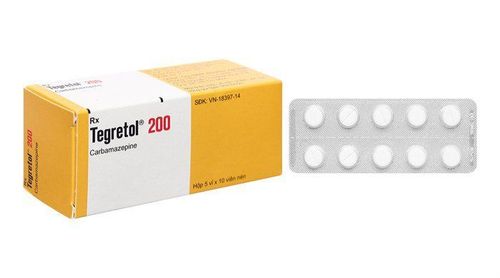This is an automatically translated article.
Vimpat drug is prepared in the form of an infusion solution, with the main ingredient being lacosamide. The drug is used in the treatment of epilepsy in adults.
1. What are the effects of Vimpat?
What does Vimpat do? Vimpat is a solution for infusion of 10mg/ml. Each ml of solution for infusion contains 10 mg of lacosamide. Each 20ml vial of solution for infusion contains 200mg of lacosamide. Lacosamide is a functional amino acid used in the adjuvant treatment of partial seizures and diabetic neuropathy. Recent studies have shown that lacosamide affects only neurons that are depolarized or active for long periods of time (typically those that focus on seizures only). This effect is in contrast to other antiepileptic drugs such as lamotrigine or carbamazepine which slow the recovery, inactivity of neurons.
Indications for use of Vimpat:
Adjuvant treatment of partial-onset epilepsy with/without secondary generalization in epilepsy patients who are adults and children 16-18 years old. Contraindications to using Vimpat:
People who are sensitive to active ingredients and excipients of the drug; Patients with 2nd or 3rd degree atrioventricular block.
2. Usage and dosage of Vimpat
How to use: Vimpat solution for infusion is used as an alternative to patients who are temporarily unable to use oral drugs. The drug solution will be infused over 15 - 60 minutes x 2 times / day. The solution can be administered intravenously without further dilution. Switching between oral and intravenous lines can be performed directly without the need for dose detection. The total daily dose and twice-daily dosing regimen should be maintained. There is now experience with the infusion of Vimpat twice daily with a treatment duration of up to 5 days.
Dosage: Can be started orally or intravenously:
Use Vimpat 2 times a day. The recommended starting dose is 50 mg/time x 2 times/day. After 1 week, the therapeutic dose can be increased to 100mg/time x 2 times/day; May start with a single starting dose of 200mg, after 12 hours a maintenance dose of 100mg, orally twice a day (equivalent to 200mg/day). A single starting dose may be initiated in patients in whom the physician is certain that steady state lacosamide plasma concentrations will be rapidly achieved, where efficacy is assured. The use of a single starting dose should be monitored and considered, as it may increase the incidence of CNS adverse reactions; Depending on the patient's tolerability and response, the maintenance dose may be increased by 50 mg/time x 2 times/day every week until the maximum recommended dose is 400 mg (200 mg/time x 2 times). /day). If the drug must be discontinued, Vimpat should be discontinued gradually, eg gradually reducing the daily dose to a increment of 200 mg/week. Overdose: There is still relatively little experience with lacosamide overdose in humans. Overdose symptoms that may occur with 1200 mg/day include dizziness and nausea (mainly central nervous system and gastrointestinal tract), which are resolved by adjusting the dose. The highest reported overdose was 12 g orally in combination with other antiepileptic drugs at toxic doses. Initially, the patient was in a coma, then recovered completely and left no sequelae.
There is currently no specific antidote in case of lacosamide overdose. Treatment of overdose includes systemic supportive measures and hemodialysis if necessary.
3. Side effects of Vimpat
When using Vimpat, patients may experience some side effects such as:
Blood and lymph: Agranulocytosis; Immune system: Hypersensitivity reactions; Psychiatric: Depression, confusion, insomnia, agitation, euphoria, aggression, psychosis, suicidal ideation, suicidal behavior, hallucinations; Nervous system: Headache, dizziness, balance disorder, lethargy, tremor, abnormal coordination, memory impairment, cognitive disorder, nystagmus, speech disorder, decreased sensation, attention disorder; Eyes: Blurred vision, double vision; Ears and labyrinths: Tinnitus, dizziness; Cardiovascular: Atrioventricular block, atrial fibrillation, atrial flutter, bradycardia; Digestive system: Nausea, vomiting, flatulence, constipation, indigestion, dry mouth; Hepatobiliary: Abnormalities in liver function tests; Skin and subcutaneous tissue: Skin itching, rash, angioedema, urticaria; Systemic and injection sites: Asthenia, gait changes, erythema, fatigue, irritability, pain or discomfort at the injection site, irritation; Injuries, poisoning and complications: Fall, stretch marks.
4. Be careful when using Vimpat
Before and while taking Vimpat, patients should be aware of:
Treatment with lacosamide can cause dizziness, increasing the risk of injury from accidents or falls. Therefore, patients should be cautious until they get used to the effects of the drug; Several studies have documented lacosamide to prolong the PR interval. In patients with conduction disturbances or severe heart disease such as a history of myocardial infarction or heart failure, lacosamide should be used with caution. Special care should be taken when administering the drug to the elderly because they are at high risk of cardiovascular disorders. Caution should be exercised when lacosamide is co-administered with drugs associated with prolongation of the PR interval; Second degree or higher atrioventricular block may occur with the drug. Atrial fibrillation or flutter may occur when lacosamide is used to treat patients with epilepsy. Patients should be informed of symptoms of 2nd degree or higher atrioventricular block (bradycardia, irregular heartbeat, dizziness and fainting) and symptoms of atrial fibrillation, atrial flutter (arrhythmia) , tachycardia, shortness of breath). Patients should consult a doctor when experiencing these symptoms; Suicidal intention and behavior may occur in patients receiving antiepileptic drugs, the possibility of lacosamide cannot be excluded. Therefore, the patient's signs of suicidal ideation and behavior should be monitored, and appropriate treatment options should be considered. Patients and caregivers should consult a physician when signs of suicidal ideation and behavior appear; Vimpat contains sodium, so it should be considered when using the drug in patients who need to control salt intake; Lacosamide should not be used during pregnancy, unless clearly needed after a benefit-risk assessment has been made by a physician. If a woman decides to become pregnant, a careful assessment of drug use is required; It is not known whether lacosamide is excreted in breast milk or not, so it is prudent to discontinue breastfeeding while taking the drug; Vimpat has mild or moderate influence on the ability to drive or use machines as a side effect of dizziness or blurred vision. Therefore, patients are advised not to drive or operate machinery until they are familiar with the side effects of the drug and can safely perform the above actions.
5. Vimpat drug interactions
Some drug interactions of Vimpat include:
Lacosamide should be used with caution in patients being treated with drugs associated with prolongation of the PR interval (eg, lamotrigine, carbamazepine, pregabalin) and in patients taking class I antiarrhythmic drugs. However, analysis in clinical trials showed that concomitant administration of lacosamide and lamotrigine or carbamazepine did not detect prolongation of the PR interval; Strong enzyme inducers such as rifampicin or fenugreek may reduce total circulating lacosamide. Therefore, caution should be exercised when starting or stopping treatment with these enzyme inducers; Co-administration of lacosamide with other antiepileptic drugs that are enzyme inducers such as carbamazepine, phenobarbital, phenytoin at different doses resulted in a 25% reduction in total circulating lacosamide. When prescribed Vimpat to treat epilepsy, the patient should coordinate with all the requirements of the doctor to ensure the best treatment effect and limit the risk of some dangerous side effects.
Follow Vinmec International General Hospital website to get more health, nutrition and beauty information to protect the health of yourself and your loved ones in your family.
Please dial HOTLINE for more information or register for an appointment HERE. Download MyVinmec app to make appointments faster and to manage your bookings easily.













